
Concept explainers
(a)
Interpretation:
The difference in the proton NMR spectra of the given compound is to be stated.
Concept introduction:
The NMR stands for nuclear magnetic resonance. NMR spectroscopy deals with the interaction between
Answer to Problem 13.44AP
The difference in the proton NMR spectra of the compound A and compound B is that compound A contains a doublet and septet and compound B contains only singlet.
Explanation of Solution
The given compounds are shown below.
The formula used to determine NMR splitting is shown below.
Where
• n is the number of hydrogen atom on the adjacent atom.
The structure of compound A is shown below.
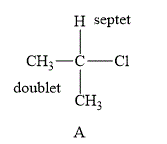
Figure 1
The compound A shown in Figure 1 contains six methyl protons and one methyne proton. The number of hydrogen atoms on adjacent atom of methyl protons
Therefore, the NMR spectra of methyl protons splits into a doublet as the number of peaks is
NMR spectra of methyne protons splits into septet as the number of peaks is
The structure of the compound

Figure 2
The compound B shown in Figure 2 contains six methyl protons. The number of hydrogen atoms on adjacent atom of methyl protons
The NMR spectra of methyl protons splits into singlet as the number of peaks is 0. As a result, there is no coupling. Therefore, the methyl protons give a singlet peak.
The compound A gives septet and doublet whereas compound B gives a singlet in proton NMR spectra.
(b)
Interpretation:
The difference in the proton NMR spectra of the given compound is to be stated.
Concept introduction:
The NMR stands for nuclear magnetic resonance. NMR spectroscopy deals with the interaction between electromagnetic radiation and the nucleus of an atom. NMR spectroscopy is used to determine the structural information about compounds.
Answer to Problem 13.44AP
The difference in the proton NMR spectra of the compound A and compound B is that compound A contains two triplets and compound B contains two triplets and one quintet (multiplet).
Explanation of Solution
The given compounds are shown below.
The formula used to determine NMR splitting is shown below.
Where
• n is the number of hydrogen atom on the adjacent atom.
The structure of compound A is shown below.
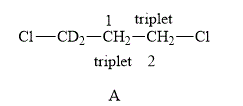
Figure 3
The compound A shown in Figure 3 contains four methylene protons. The methylene protons are adjacent to each other. Therefore, both of them couple with each other. The value of hydrogen atoms
Therefore, the NMR spectra of methyl protons of
Therefore, the NMR spectra of methyl protons of
The structure of compound B is shown below.
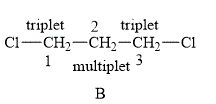
Figure 4
The compound B shown in Figure 4 contains six methylene protons. The methylene protons are adjacent to each other. The value of hydrogen atoms
Therefore, the NMR spectra of methyl protons of
Therefore, the NMR spectra of methyl protons of
The protons on the adjacent of
Therefore, the NMR spectra of methyl protons of
The compound A gives triplet at both the carbons whereas compound B gives triplet on
(c)
Interpretation:
The difference in the proton NMR spectra of the given compound is to be stated.
Concept introduction:
The NMR stands for nuclear magnetic resonance. NMR spectroscopy deals with the interaction between electromagnetic radiation and the nucleus of an atom. NMR spectroscopy is used to determine the structural information about compounds.
Answer to Problem 13.44AP
The difference in the proton NMR spectra of the compound A and compound B is that compound A contains a doublet and septet and compound B contains only singlet.
Explanation of Solution
The formula used to determine NMR splitting is shown below.
Where
• n is the number of hydrogen atom on the adjacent atom.
The structure of compound A and B are shown below.
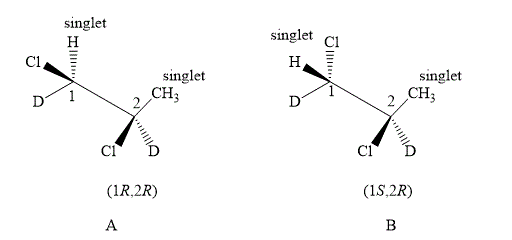
Figure 5
The compound A and B shown in Figure 5 both have similar spectrums. In the compound A, the value of number of methyl protons on adjacent to
Therefore, the NMR spectra of methyl protons of
Therefore, the NMR spectra of methyl protons of
Compound A and compound B both are diastereotopic. The chemical shift value of both the compounds is slightly different. The spectrum of both compounds is the same as there are diastereoisomers. Therefore, compound B also forms singlet on both the carbons.
The structure of compound C is shown below.
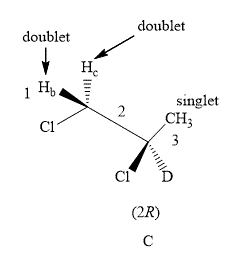
Figure 6
The compound C shown in Figure 6 contains five equivalent protons. The value of hydrogen atoms
Therefore, the NMR spectra of methyl protons of
Therefore, the NMR spectra of methyl protons of
The number of peaks of both
Therefore, the NMR spectra of methyl protons of
The compound A gives triplet at both the carbons whereas compound B gives triplet on
Want to see more full solutions like this?
Chapter 13 Solutions
Organic Chemistry
- Write "most" under the most acidic compound. Write "least" under the least acidic compound. OH NO₂ OCH3 Br 9. Compound X, C50H84F2, reacts with excess H2/Pd to give a C50H88F2 compound. How many rings are in X? How many double bonds are in X? Show your work.arrow_forward4. State whether these two are: a) the same molecule b) c) d) different compounds that are not isomers constitutional isomers diastereomers e) enantiomers CH3 CH₁₂ H OH HO H H OH HO H CH, CH₂ 5. a) How many stereocenters does this compound have? b) How many stereoisomers are possible for this compound? CH₂ OH CHCHarrow_forwardCalculating the pH at equivalence of a titration A chemist titrates 210.0 mL of a 0.1003 M hydrobromic acid (HBr) solution with 0.7550M KOH solution at 25 °C. Calculate the pH at equivalence. Round your answer to 2 decimal places. Note for advanced students: you may assume the total volume of the solution equals the initial volume plus the volume of KOH solution added. pH = ] ☑ o0o 18 Ararrow_forward
- Do you do chemistry assignmentsarrow_forwardUsing the conditions of spontaneity to deduce the signs of AH and AS Use the observations about each chemical reaction in the table below to decide the sign (positive or negative) of the reaction enthalpy AH and reaction entropy AS. Note: if you have not been given enough information to decide a sign, select the "unknown" option. reaction observations conclusions A This reaction is always spontaneous, but proceeds slower at temperatures above 120. °C. ΔΗ is (pick one) AS is (pick one) ΔΗ is (pick one) B This reaction is spontaneous except above 117. °C. AS is (pick one) ΔΗ is (pick one) This reaction is slower below 20. °C than C above. AS is |(pick one) ? 18 Ar 1arrow_forwardCalculating the pH at equivalence of a titration Try Again Your answer is incorrect. 0/5 a A chemist titrates 70.0 mL of a 0.7089 M hydrocyanic acid (HCN) solution with 0.4574M KOH solution at 25 °C. Calculate the pH at equivalence. The pK of hydrocyanic acid is 9.21. Round your answer to 2 decimal places. Note for advanced students: you may assume the total volume of the solution equals the initial volume plus the volume of KOH solution added. pH = 11.43] G 00. 18 Ar B•arrow_forward
- Biological Macromolecules Naming and drawing the products of aldose oxidation and reduction aw a Fischer projection of the molecule that would produce L-ribonic acid if it were subjected to mildly oxidizing reaction conditions. Click and drag to start drawing a structure. X AP ‡ 1/5 Naor Explanation Check McGraw Hill LLC. All Rights Reserved. Terms of Use Privacy Center Accessibilarrow_forward● Biological Macromolecules Identifying the parts of a disaccharide Take a look at this molecule, and then answer the questions in the table below it. CH2OH O H H H OH OH OH H H CH2OH H O OH H OH H H H H OH Is this a reducing sugar? Does this molecule contain a glycosidic bond? If you said this molecule does contain a glycosidic bond, write the symbol describing it. If you said this molecule does contain a glycosidic bond, write the common names (including anomer and enantiomer labels) of the molecules that would be released if that bond were hydrolyzed. If there's more than one molecule, separate each name with a comma. Explanation Check O yes X O no ○ yes O no Uarrow_forwardThe aim of the lab is to measure the sodium content from tomato sauce using the Mohr titration method. There are two groups being: Regular Tomato sauce & Salt Reduced tomato sauce QUESTION: State how you would prepare both Regular & Salt reduced tomato sauce samples for chemical analysis using the Mohr titration methodarrow_forward
- Using the conditions of spontaneity to deduce the signs of AH and AS Use the observations about each chemical reaction in the table below to decide the sign (positive or negative) of the reaction enthalpy AH and reaction entropy AS. Note: if you have not been given enough information to decide a sign, select the "unknown" option. reaction observations conclusions A The reverse of this reaction is always spontaneous but proceeds faster at temperatures above -48. °C. ΔΗ is (pick one) ✓ AS is (pick one) B This reaction is spontaneous except below 114. °C but proceeds at a slower rate below 135. °C. ΔΗ is (pick one) AS is (pick one) ΔΗ is C This reaction is exothermic and proceeds faster at temperatures above -43. °C. (pick one) AS is (pick one) v Х 5 ? 18 Ararrow_forwardion. A student proposes the following Lewis structure for the perchlorate (CIO) io : :0: : Cl : - - : :0: ك Assign a formal charge to each atom in the student's Lewis structure. atom central O formal charge ☐ top O ☐ right O ☐ bottom O ☐ Cl ☐arrow_forwardDecide whether these proposed Lewis structures are reasonable. proposed Lewis structure Yes. Is the proposed Lewis structure reasonable? Cl- : 2: :Z: :Z: N—N : 0: C C1: O CO No, it has the wrong number of valence electrons. The correct number is: ☐ No, it has the right number of valence electrons but doesn't satisfy the octet rule. The symbols of the problem atoms are:* ☐ Yes. No, it has the wrong number of valence electrons. The correct number is: ☐ No, it has the right number of valence electrons but doesn't satisfy the octet rule. The symbols of the problem atoms are:* | Yes. No, it has the wrong number of valence electrons. The correct number is: No, it has the right number of valence electrons but doesn't satisfy the octet rule. The symbols of the problem atoms are:* | If two or more atoms of the same element don't satisfy the octet rule, just enter the chemical symbol as many times as necessary. For example, if two oxygen atoms don't satisfy the octet rule, enter "0,0". ☑arrow_forward
 ChemistryChemistryISBN:9781305957404Author:Steven S. Zumdahl, Susan A. Zumdahl, Donald J. DeCostePublisher:Cengage Learning
ChemistryChemistryISBN:9781305957404Author:Steven S. Zumdahl, Susan A. Zumdahl, Donald J. DeCostePublisher:Cengage Learning ChemistryChemistryISBN:9781259911156Author:Raymond Chang Dr., Jason Overby ProfessorPublisher:McGraw-Hill Education
ChemistryChemistryISBN:9781259911156Author:Raymond Chang Dr., Jason Overby ProfessorPublisher:McGraw-Hill Education Principles of Instrumental AnalysisChemistryISBN:9781305577213Author:Douglas A. Skoog, F. James Holler, Stanley R. CrouchPublisher:Cengage Learning
Principles of Instrumental AnalysisChemistryISBN:9781305577213Author:Douglas A. Skoog, F. James Holler, Stanley R. CrouchPublisher:Cengage Learning Organic ChemistryChemistryISBN:9780078021558Author:Janice Gorzynski Smith Dr.Publisher:McGraw-Hill Education
Organic ChemistryChemistryISBN:9780078021558Author:Janice Gorzynski Smith Dr.Publisher:McGraw-Hill Education Chemistry: Principles and ReactionsChemistryISBN:9781305079373Author:William L. Masterton, Cecile N. HurleyPublisher:Cengage Learning
Chemistry: Principles and ReactionsChemistryISBN:9781305079373Author:William L. Masterton, Cecile N. HurleyPublisher:Cengage Learning Elementary Principles of Chemical Processes, Bind...ChemistryISBN:9781118431221Author:Richard M. Felder, Ronald W. Rousseau, Lisa G. BullardPublisher:WILEY
Elementary Principles of Chemical Processes, Bind...ChemistryISBN:9781118431221Author:Richard M. Felder, Ronald W. Rousseau, Lisa G. BullardPublisher:WILEY





